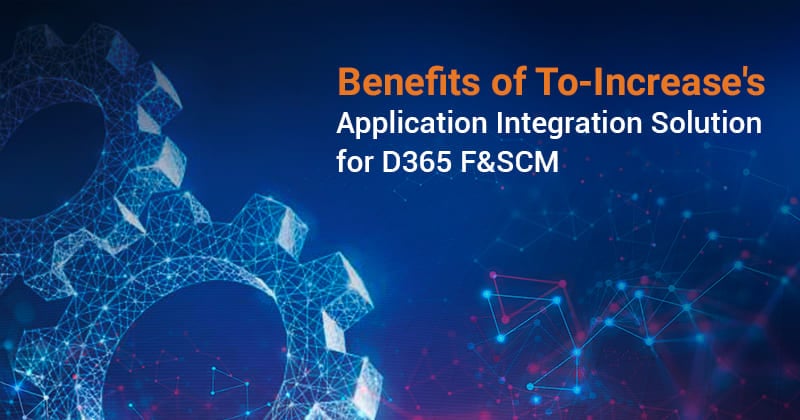12 Benefits of STAEDEAN's Data Integration Solution for D365 F&SCM
 James Smith
James Smith
Table of contents
Data created, copied, distributed, and consumed is growing at a rapid pace. According to Statista, the total amount of data created globally reached 64.2 zettabytes in 2020 and is forecasted to reach 147 zettabytes in 2024. Additionally, the number of applications and business systems used by organizations is also growing at an alarming pace. According to another report by Statista, the revenue in the enterprise software segment worldwide is projected to reach US$237.10bn in 2022. So, if enterprises are spending on software, they also need to look at an integration platform to connect their system and avoid data silos.
Evaluating integration solutions is not easy as not all integrations are the same; some integrations require technical expertise or more flexible solutions. As we have built a solution for application integration—Data Integration Solution for Microsoft Dynamics 365 Finance & Supply Chain Management (D365 F&SCM), we understand customer pain points around integrations. We upgraded our integration solution with a performance monitoring feature that allows our customers to track the health of their configured integrations.
In this article, we share the top 12 advantages of our integration engine and performance monitoring application that can help you integrate your application landscape and also help you with data preparation and extraction.
Benefits of Data Integration Solution for D365 F&SCM
1) Embedded integration solution
Our application integration solution is built using the same business logic and code as Dynamics 365 and offers the same familiar user experience as the Dynamics 365 environment. It can be accessed from the dashboard once you log into D365 ERP. Using our Data Integration Solution, you can transfer data seamlessly in and out of the ERP, and any incoming data can be validated in the Dynamics 365 database.
What makes us stand out from the competition is that while other solutions need to be integrated with the D365 ERP, our solutions are embedded in D365, so even implementation is easier and the user- experience is familiar.
Related reading: How Well Are STAEDEAN’s EDI and Integration Solutions Integrated with Microsoft D365?
2) Easy-to-use, configuration-based solution
Since our solution is embedded within D365 ERP, it offers the same user experience that our customers are already familiar with, so the learning curve is quicker and flatter. Our solution provides built-in tutorials, so it is easier for our customers to get started with our Data Integration Solution after the initial training. Also, since our solution has been built keeping business users in mind, it allows you to add integrations by simple configuration, so no coding skills are needed to configure new integrations or to monitor your integrations within D365 F&SCM.
3) Works with Microsoft upgrades
Before Microsoft updates their ERP, we receive the updates two weeks in advance, giving us enough time to test and work on our solutions, if needed. Even if Microsoft adds or updates a functionality, our solutions will work without any coding at your end.
4) Flexible
Mapping during integration using Microsoft’s current data entities as is with different systems and applications is difficult unless you use a solution like Data Integration Solution or start development. Since our solution allows our customers to use any table, view, and data entities, or a combination to configure integrations in D365 F&SCM, you can easily map and customize fields to manage your integrations and are not limited to using the existing data entities within the Data Management Framework in Dynamics 365.
5) Synchronize data quickly
Data Integration Solution leverages the existing functionality in Dynamics 365 to transfer data in and out of the D365 database. Using our application integration engine, you can split files during extract and load to utilize each batch server available on D365. This will drastically improve the processing time of the integrated records and data synchronization.
6) Data management for multiple scenarios
Using Data Integration Solution, you can segregate and synchronize data and manage multiple scenarios. With Dynamic 365, you can maintain different ledger accounts separately, also known as companies, into one system. Segregating this data can be difficult during an integration. So, if you want to migrate data, you can use our Data Migration Solution to import data into multiple companies simultaneously while using a mapping specific to each company.
During an integration with business systems such as the CRM for example, it is possible that data fields in different systems are identified differently. Using D365 ERP, you cannot map integrations unless the field names are the same but using our integration platform you can customize this. For each field mapping, you can set up constants, defaults, conversions, and transformations to ensure smooth integration and data synchronization between several business systems.
7) Options of connectors and document formats
With Data Integration Solution, you can configure technical integration by using any of the following connectors - the web services, file system (folders), SharePoint, SFTP, email, D365 F&SCM database, or data connection with ODBC.
Additionally, Data Integration Solution supports and can read files of several document formats, including Microsoft Excel, Delimiter-based (CSV), JSON, flat file, Microsoft Word, EDI, fixed text, ODBC, and XML file (with XSD or XSLT). And custom formats can be used as well.
8) Automated synchronization of data
After the initial implementation, you can set up an integration and re-use to automate integrations quickly. Data Integration Solution also offers a rich transformation library to help you with automation. After that, whenever anyone in your team updates the integration, in case of any changes, an event log can be applied for each connection. Once this has been done, the database triggers will detect insertions, deletions, and updates, if any, and only the changes in data will be synchronized.
9) Real-time insights on integrations
Data Integration Solution offers an integration monitoring application built on the Dataverse, and leveraging the Power Platforms that draws out real-time insights on its dashboard on all your integrations in real-time. The app makes it easy for you to track the health of your integrations on the move, as it can be accessed on both mobile phones and tablets. You can track slow-performing integrations, integration errors, peak message flow times during the day, the number of records with errors, and many more such metrics through the application. These metrics will help you gauge the health of your integrations and help you ensure that you can optimize slow and lagging integrations proactively rather than reactively when an integration fails.
10) Act quickly in case of integration errors
The solution's integration monitoring app displays when there is an integration failure, if any, across your ‘Companies’ and ‘Applications’ involved in the dashboard. It is also easy to compartmentalize errors by Project, Application, Company, etc. You can use the actionable message log feature to track the URL of the issue and find a resolution quickly. Additionally, you can set up notifications for such events on Teams so that the respective team member can automatically be notified in case of an integration failure or error message.
11) Extend to other applications
If you need a solution for electronic data interchange or master data management, both these solutions are built on our integration engine as a base and easily integrate and leverage the capabilities of our integration solution. Additionally, Data Integration Solution's integration monitoring app can track EDI and MDM messages with various vendors or across various legal entities. If you decide to implement our Data Governance Solution and EDI Studio solution, you could track your integrations and MDM and EDI messages all in one place using the monitoring app.
12) Simplified data preparation
Data Integration Solution helps you easily process large data volumes and simplify the entire data preparation and extraction process by modeling, cleaning, transforming, and combining your Dynamics 365 F&SCM data. So you can accelerate the time to market on analytics delivery by empowering your data stewards to load, clean, classify, prepare, and extract data in D365 F&SCM easily, without relying on a skilled workforce.
Are you ready to explore our Data Integration Solution for D365?
In this article, we have shared 12 reasons why you should consider our integration solution for Dynamics 365 F&SCM. If you are looking for an integration solution for Dynamics 365 that supports a variety of formats, is flexible to use, and can monitor integration performance then you can explore STAEDEAN's Data Integration Solution.
Our integration solution can help you scale and integrate your entire application landscape, including complicated integrations, for example, integrating an on-premises system with a cloud application.
Additionally, Data Integration Solution can also help you manage large data exports from D365 F&SCM with high speed and agility, simplify data preparation and extraction based on the required formats of external systems, and easily validate master data records in D365 F&SCM with a single click during data exports.
To learn more, please download our solution factsheet from the link given below.

